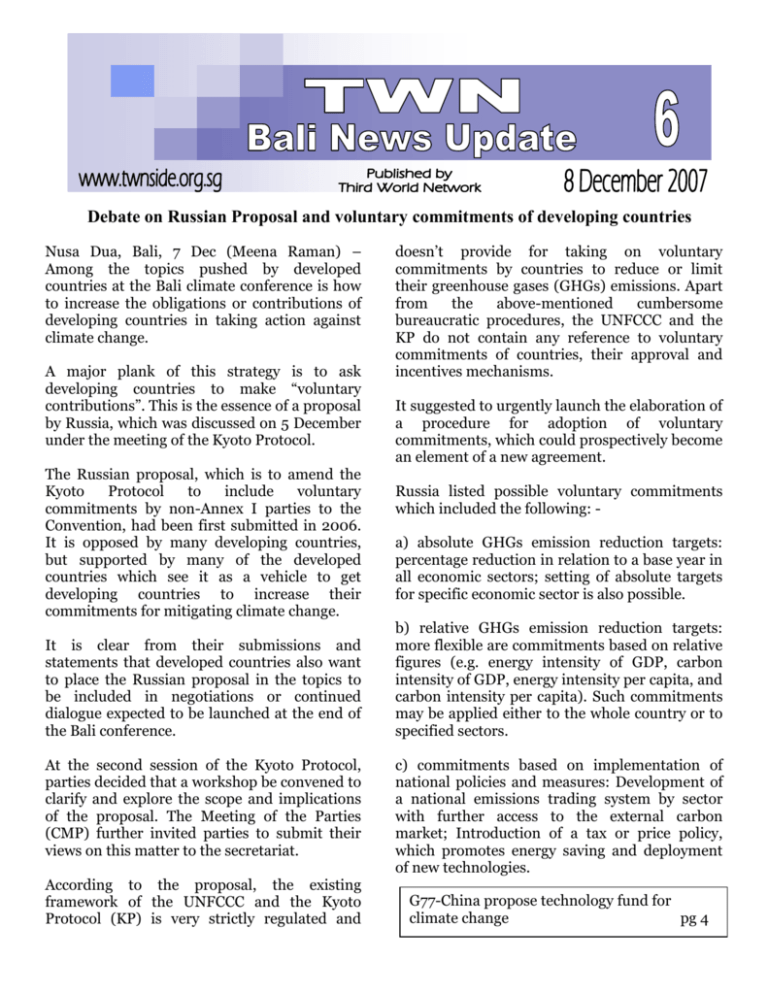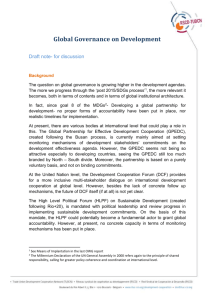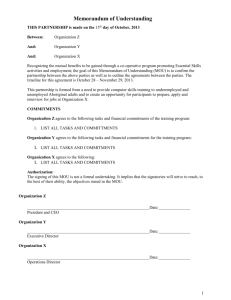Debate on Russian Proposal and voluntary commitments of
advertisement

Debate on Russian Proposal and voluntary commitments of developing countries Nusa Dua, Bali, 7 Dec (Meena Raman) – Among the topics pushed by developed countries at the Bali climate conference is how to increase the obligations or contributions of developing countries in taking action against climate change. A major plank of this strategy is to ask developing countries to make “voluntary contributions”. This is the essence of a proposal by Russia, which was discussed on 5 December under the meeting of the Kyoto Protocol. The Russian proposal, which is to amend the Kyoto Protocol to include voluntary commitments by non-Annex I parties to the Convention, had been first submitted in 2006. It is opposed by many developing countries, but supported by many of the developed countries which see it as a vehicle to get developing countries to increase their commitments for mitigating climate change. It is clear from their submissions and statements that developed countries also want to place the Russian proposal in the topics to be included in negotiations or continued dialogue expected to be launched at the end of the Bali conference. At the second session of the Kyoto Protocol, parties decided that a workshop be convened to clarify and explore the scope and implications of the proposal. The Meeting of the Parties (CMP) further invited parties to submit their views on this matter to the secretariat. According to the proposal, the existing framework of the UNFCCC and the Kyoto Protocol (KP) is very strictly regulated and doesn’t provide for taking on voluntary commitments by countries to reduce or limit their greenhouse gases (GHGs) emissions. Apart from the above-mentioned cumbersome bureaucratic procedures, the UNFCCC and the KP do not contain any reference to voluntary commitments of countries, their approval and incentives mechanisms. It suggested to urgently launch the elaboration of a procedure for adoption of voluntary commitments, which could prospectively become an element of a new agreement. Russia listed possible voluntary commitments which included the following: а) absolute GHGs emission reduction targets: percentage reduction in relation to a base year in all economic sectors; setting of absolute targets for specific economic sector is also possible. b) relative GHGs emission reduction targets: more flexible are commitments based on relative figures (e.g. energy intensity of GDP, carbon intensity of GDP, energy intensity per capita, and carbon intensity per capita). Such commitments may be applied either to the whole country or to specified sectors. c) commitments based on implementation of national policies and measures: Development of a national emissions trading system by sector with further access to the external carbon market; Introduction of a tax or price policy, which promotes energy saving and deployment of new technologies. G77-China propose technology fund for climate change pg 4 TWN Bali Update No.6 2 8 December 2007 d) commitments based on development, deployment and expansion of low-carbon technologies. climate change. It recognized the fact that action by developed countries alone cannot fulfill the objective of the Convention. The proposal further stated that the voluntary commitments could be conditional and unconditional. For conditional commitments, “a Party takes on commitments under the condition that it will be provided with technologies/financing in order to achieve voluntary targets.” Australia noted the relevance of the Russian proposal to Parties’ ongoing discussions on future action under the Convention and the Protocol. In relation to unconditional commitments, “a Party achieves voluntary targets using its own resources, and uses the resulting benefits to attain its own development goals.” Russia also proposed that to make a framework for voluntary commitments effective, it is important to ensure the following: a. Determination and assessment of voluntary targets. b. Determination of baselines and verification of the achieved emission reductions. c. Approval of appropriate incentives by all the UNFCCC Parties. d. Approval of the UNFCCC decision package on adoption of the voluntary commitments. The proposal also suggested that in the elaboration of new procedures under the UNFCCC provisions, “While considering a system for voluntary commitments, it is necessary to introduce a new differentiation principle for countries according to the level of their economic development and national circumstances.” In response to the Russian proposal, various government made written submissions for the consideration of the CMP, in addition to making oral statements in plenary. Australia supported the Russian proposal, stating that appropriate procedures be developed to enable parties to the Kyoto Protocol and the Convention to adopt voluntary commitments. “The proposal is consistent with Australia’s view that all major emitters need to be involved in future action on China in its submissions said that the contents and concepts of the voluntary commitments proposed by the Russia have already been covered in Article 4.1 of the UNFCCC and other relevant provisions of the Kyoto Protocol, and all Parties are implementing their commitments under that provision. “So there is no added value to develop additional procedures for taking these commitments, said China. Any Party can take whatever policies and measures it likes to address climate change according to Article 4.1 of the Convention and other relevant provisions of the Kyoto Protocol.” India in its submissions said that the "procedural" and "substantive" components of the proposal appear to relate to two quite different matters. “The "procedural" question relates to the voluntary accession of a non-Annex I party to Annex I (for the purposes of the Kyoto Protocol) and the related question of determining its quantified emission limitation and reduction commitments. In contrast, the "substantive" component concerns other nonAnnex I parties. “In our view, there is no need to "simplify" procedures for accession to Annex I (for the purposes of the Kyoto Protocol. It would be sufficient to clarify the existing provisions. As regards the "substantive" component, our view is that the existing provisions of Article 4 of UNFCCC require no addition or amendment.” (Article 4 of the Convention refers to the commitments of parties). Japan in its submissions supported the Russian proposal to develop appropriate procedures for the approval of voluntary commitments for those Parties that are not included in Annex I of the TWN Bali Update No.6 3 8 December 2007 Convention. “The proposal encourages global efforts to stabilize GHG concentrations.” not included in Annex I to the Convention in the collective effort to protect the climate. On how the proposal should be addressed, Japan submitted that the adding of Parties to Annex I of the Convention and Annex B of the Protocol by the amendments of the Convention and the Protocol, as well as the issue of simplification of those procedures, and the other was the issue of identifying what should be regarded as voluntary commitments by the parties that are not included in Annex I of the Convention. It added that the voluntary actions could be of different types, for example aiming at achieving emission targets, implementing policies and measures, or promoting technological deployment and would not impose penalties on a non- Annex I Party for not implementing fully the actions it had proposed. New Zealand submitted that it supported the Russian goal. It said the Russian proposal be placed as a new agenda item on the COP and CMP agendas. The EU submitted that the European Council stressed that international collective action will be critical in driving an effective, efficient and equitable response on the scale required facing climate change challenges. To this end, negotiations on a global and comprehensive post-2012 agreement, which should build upon and broaden the Kyoto Protocol architecture and provide a fair and flexible framework for the widest possible participation, need to be launched in Bali and completed by 2009. All countries should be invited to contribute to the efforts under this framework according to their common but differentiated responsibilities and respective capabilities. The EU said that developed countries should continue to take the lead by committing to collectively reducing their emissions of greenhouse gases in the order of 30% by 2020 compared to 1990. They should do so also with a view to collectively reducing their emissions by 60% to 80% by 2050 compared to 1990. The EU said the Russian proposal has two components. The first aims at simplifying the procedures governing the accession of a party to Annex I. The second component aims to explore new forms of engagement for Parties The EU in its submission said incentives for voluntary contributions would have to be additional to any existing benefits under the Convention. The issue of recognizing or providing incentives for voluntary contributions deserve to be explored further. It also hinted that Russian proposal should be placed as an issue in the dialogue or negotiations for a new comprehensive agreement. South Korea in its submissions supported the Russian proposal. It suggested a variety of different commitments while providing incentives for commitments. In addition, punitive aspects to the efforts of developing countries must be avoided. Several delegations also spoke at the plenary in addition to their submissions. This included Belarus, Canada, India, Australia, the EU, New Zealand, South Korea and Japan. They made very brief interventions. The EU said that the Russian proposal should be dealt with seriously and asked for the proposals to be studied further. Canada and Belarus supported the Russian proposal. Saudi Arabia questioned the words “voluntary commitments” which it said was contradictory, as “how can commitments be voluntary.” In conclusion, Indonesian Minister Rachmat Witoelar as the CMP President invited Mr. Djismun Kasri of Indonesia to speak with parties on the issue and provide him with advice on how to proceed on the matter. TWN Bali Update No.6 G77-China propose technology fund for climate change Nusa Dua, Bali, 7 Dec (Hira Jhamtani) -Developing countries, grouped under the G77 and China, have proposed at the Bali climate conference that a new multilateral cooperation fund be set to finance the development, diffusion and transfer of environmentally sound technologies to developing countries. This was the highlight of the G77’s paper on “Proposed elements for a draft decision on Development and Transfer of Technologies” at the Bali Climate Conference today. The paper was presented at a contact group under the Subsidiary Body for Implementation (SBI) of the United Nations Framework Convention on Climate Change (UNFCCC) during its 13th session. The proposal came after G77 and China insisted that the technology transfer issue is very important to adapt to and mitigate climate change, and successfully proposed that it be discussed in SBI to ensure that the commitments of developed countries be implemented. The paper delivered by Ghana on behalf of G77 and China referred to the fact that the current institutional, financial and monitoring arrangement under the Convention are inadequate to deliver immediate and urgent transfer of technologies to developing countries. It proposed to establish a new and additional multilateral technology cooperation fund to finance the development, deployment, diffusion and transfer of environmentally sound technologies for mitigation and adaptation to developing countries. The funding arrangement will inter alia: * support implementation of technology needs assessments; 4 8 December 2007 * participate in joint research and development programmes and activities in developing new technologies; * conducting demonstration projects; * establishing enabling environments for technology transfer; * providing incentives for private sector engagement; * support North-South and South-South cooperation; * developing and enhancing endogenous capacities and technologies; * meeting the agreed incremental costs; * purchasing licenses to support transfer of low carbon technologies and infrastructure. * provide a window for venture capital financing located in a multilateral financial institution. The paper also asked Parties, in particular developed countries, to provide technical and financial assistance to support the implementation of technology framework, that will be outlined in an annex to be attached to the decision. It requested the expert group on technology transfer to develop performance indicators to support SBI in its review and assessment of the effective implementation of Articles 4.5 and 4.1(c) of the Convention, for the SBI to consider at its 13th session. The proposal does not refer to arrangements about intellectual property rights (IPR) that have previously been identified by some developing countries as hampering transfer of technology. In response to the proposal, Canada said it will first study the paper while Japan asked that countries be given opportunity to discuss among themselves before the next informal meeting. The US said the paper can become one of the basis for discussion but reminded that other papers that may be submitted should also be used, a point supported by Canada. The group will meet again on 8 and 10 December and it will have to finish its Decision by 11 December. www.twnside.org.sg; twnet@po.jaring.my





